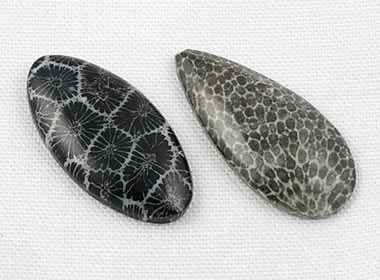Home » Gemstones » Organic Gemstones
Organic Gemstones
Some are composed of organic materials, some are fossilized organic structures.
Author: Hobart M. King, PhD, GIA Graduate Gemologist
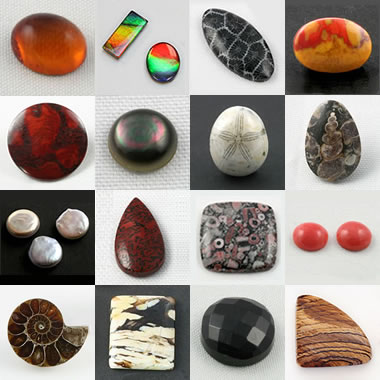
Organic Gemstones: This colorful collage features some of the organic gems of this article. Starting at the top and moving to the left are: amber, ammolite, fossil coral, petrified wood, fossil stromatolite, mother of pearl, fossil sand dollar, turritella agate, freshwater cultured pearls, fossil dinosaur bone, fossil crinoidal limestone, red coral, fossil ammonite, peanut wood, jet, and opalized wood. See below for more.
What are Organic Gems?
Although most gemstones are mineral materials, a number of organic materials are also considered to be gemstones. The most common of these are pearl, bone, amber, coral, jet, and ivory. These are materials, produced by organisms, that have been cut into gems and other ornamental objects.
There are also organic materials that have been mineralized (replaced and infilled by chalcedony, opal, calcite, aragonite, pyrite, or other mineral material). Although the material itself is not organic, it does preserve an organic structure. Examples include petrified wood, fossil coral, dinosaur bone, and other fossilized organisms or parts of organisms.
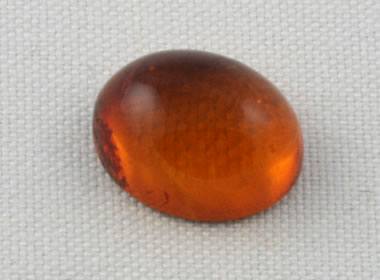
Amber is a fossilized resin that was secreted by ancient plants. It usually has a yellowish to orangish brown color but can be white, greenish, bluish, or even black. It is easily cut and polished into bright, light-weight gems.
Table of Contents
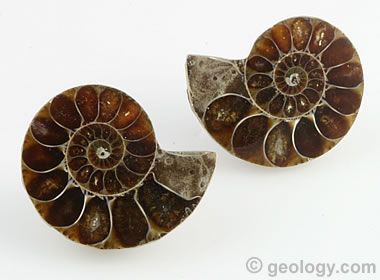
Ammonites are an extinct group of marine invertebrate animals that produced a chambered shell. Their fossilized shells are often cut and used as an ornamental or jewelry stone.
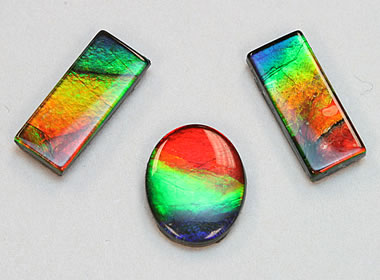
Ammolite is a trade name used for iridescent ammonite shell material. It produces a bright flash of color that rivals fine opal and labradorite. All of the world's production comes from a small area in Alberta, Canada.
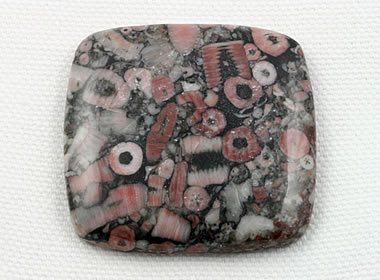
Crinoids are organisms that once lived on the ocean floor. They looked like a stemmed plant but were actually an invertebrate animal. Their fossils can be found in limestone and dolomite that can often be cut and polished into interesting gems. This cabochon is about 39 millimeters square and was cut from material found in China.
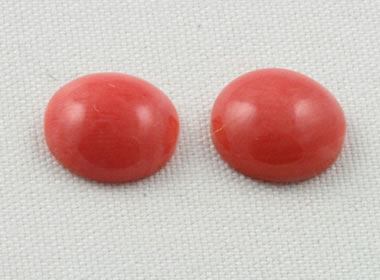
Coral cabochons: Coral is a colonial organism that lives in warm, shallow marine waters and often develops reefs. When fossilized, it is a hard calcium carbonate material that can be cut or carved and polished into beautiful gems. The coral is usually white, cream, or pink in color. Rarely it is bright red, the most desired color. These specimens of pink coral are from Taiwan.

Dinosaur bone is often petrified (fossilized by being infilled and replaced by quartz and other minerals). The quartz can be very colorful. When the petrification is thorough, the material can often be cut and polished into attractive gems.
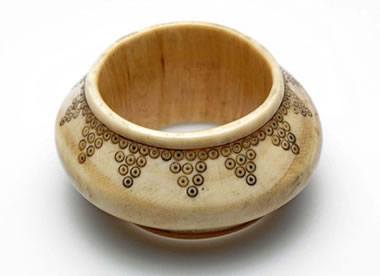
Ivory is a white- to cream-colored material that is from the tusks of elephants; the teeth of other large mammals such as hippopotamus, walrus, and wild boar; or the fossilized tusks of mammoths. It is widely carved and inscribed for use as ornamental objects and less often as gems. Most countries of the world now ban or heavily regulate the sale and import of elephant ivory. This ivory bracelet is from the Tropenmuseum Collection, and their photo is used here under a Creative Commons license.
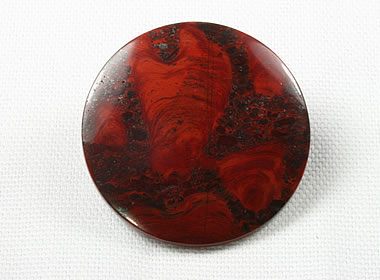
Mary Ellen Jasper is a rock found in Minnesota that consists of red jasper and silver hematite. The jasper is a fossil stromatolite, a layered structure built up by sediment-trapping algae. The algae that produced the stromatolite structures in Mary Ellen lived on Earth about two billion years ago - long before land plants.
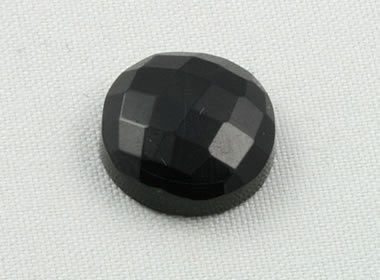
Jet: a variety of bituminous coal with a uniform texture that can be cut and polished into attractive gems. It was popular in Victorian England and used in mourning jewelry. One of the most famous jet-producing localities is near the community of Whitby on the eastern coast of England. Jet, as a form of coal, has a very low specific gravity. That makes a long strand of jet beads much lighter in weight than a similar-size strand of any other gem material except amber. Pins, pendants, and earrings made from jet are also much lighter than those made out of other materials and can be worn more comfortably.
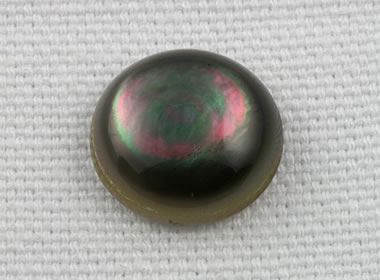
Mother of pearl, also known as "MOP," is the thin inner nacreous layer of a mollusk shell. It can have a base color of white, cream, or gray with a beautiful iridescent play-of-color. Mother of pearl has been used to produce jewelry and buttons. It has been used for fancy inlay work on musical instruments and furniture. It was much more widely used before plastic manufacturing became common.
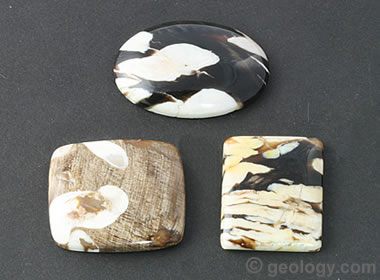
"Peanut wood": Three nice peanut wood cabochons cut from material from the Kennedy Ranges of Western Australia. For size reference, the top cab is about 30 millimeters by 20 millimeters in size. Peanut wood is a fossilized driftwood that has been intensively drilled by a boring clam. These cabs all show boreholes infilled with white radiolarian sediments in brown to black petrified woody material.
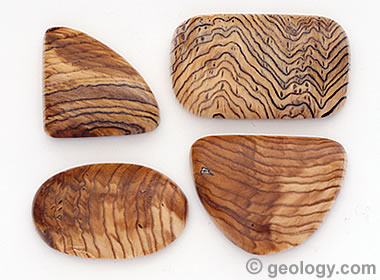
Opalized Wood: These cabochons were cut from a variety of petrified wood known as Herringbone Sequoia. The rough was found in the Snake River / Hell's Canyon area by an old-time rockhound in the mid-1900s and was sold as part of his estate. It is uncertain if it was found on the Idaho or Oregon side of the canyon. Whichever state it came from, it is a beautiful and unique material. Instead of being composed of chalcedony, like most petrified wood, it is composed of common opal. It is definitely opalized wood (specific gravity = 2.106, spot refractive index = 1.48). These cabochons were cut by Greta Schneider of Copper Creek Cabs.
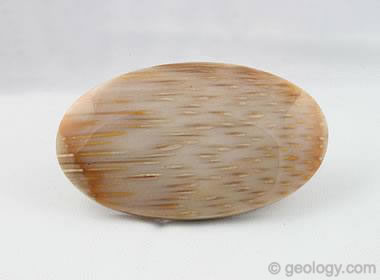
Petrified Palm: Petrified palm, also known as "petrified palm wood," is a material commonly found in the Oligocene-age sediments of the United States Gulf Coast. It is not actually a wood; instead it is fossilized parenchyma, the fibrous material that composes a palm tree. It is described in detail in our article on Louisiana gems.
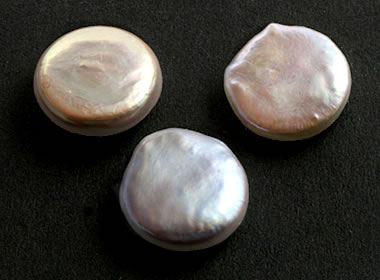
Pearls: Yes, pearls are considered to be "gemstones." They are produced by mollusks and other shellfish. People have used them as gems for thousands of years and the pearl serves as the modern birthstone for the month of June. The pearls in this photo are cultured freshwater pearls produced in Tennessee.
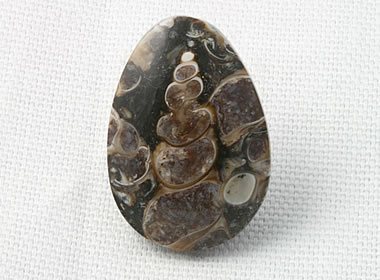
"Turritella Agate" is the name given to a brownish gem material that contains spectacular fossil snail shells entombed in a semitransparent agate. Although millions of people have called this material "Turritella" for several decades, the name is actually incorrect. It was mistakenly named after a genus of fossil snails that are very similar to the shells in the agate. The proper name of the snails is "Elimia tenera," a member of the Pleuroceridae family. Perhaps a more accurate (although less elegant) name for the material would be "Elimia Agate."
About 50 million years ago, the spiral-shaped shells accumulated in the sediments of a shallow inland sea in an area that we now know as the state of Wyoming. A few lenses of snail-bearing sediment, in what is today known as the Green River Formation, were then agatized by the deposition of fine-grained silica (chalcedony - also known as agate) into the cavities of the shells and the voids between them. If the sediment was completely agatized, it has potential lapidary (gem cutting) potential. To learn more about the Turritella - Elimia naming error, visit the Paleontological Research Institution - people who know what they are talking about when it comes to fossils.
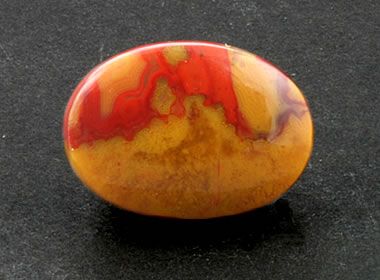
Petrified Wood is a fossil that forms when woody material is buried, then dissolved materials in groundwater precipitate to replace and infill the wood structure with silica, opal, or other mineral material.
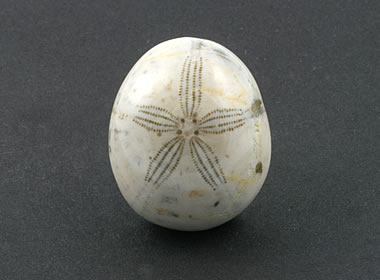
Sand Dollar: The sand dollars found on the beach today are from an ancient group of animals that has lived in the oceans for millions of years. Their bodies are often agatized by nature and then found by people who polish them into gems. This sand dollar is an agatized specimen from Mexico.
| More Gemstones |
 |
Diamond |
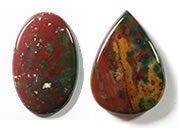 |
Bloodstone |
 |
Blue Gemstones |
 |
Tourmaline |
 |
Birthstones |
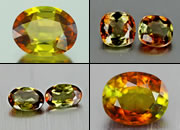 |
Andalusite |
 |
Rock Tumblers |
 |
Opalized Wood |

Find Other Topics on Geology.com:

|

| ||

|

| ||

|

| ||

|

|


